Litvaks
| Regions with significant populations | |
|---|---|
Polish Jews | |
| Part of a series on |
| Jews and Judaism |
|---|

Litvaks (
No other Jew is more closely linked to a specifically Lithuanian city than the
The inter-war Republic of Lithuania was home to a large and influential Jewish community whose members either fled the country or were murdered when the Holocaust in Lithuania began in 1941. Prior to World War II, the Lithuanian Jewish population comprised some 160,000 people, or about 7% of the total population.[4] There were over 110 synagogues and 10 yeshivas in Vilnius alone.[5] Census figures from 2005 recorded 4,007 Jews in Lithuania – 0.12 percent of the country's total population.[6]
Vilna (Vilnius) was occupied by Nazi Germany in June 1941. Within a matter of months, this famous Jewish community had been devastated with over two-thirds of its population killed.[clarification needed]
Based on data by Institute of Jewish Policy Research, as of 1 January 2016, the core Jewish population of Lithuania is estimated to be 2,700 (0.09% of the wider population), and the enlarged Jewish population was estimated at 6,500 (0.23% of the wider population). The Lithuanian Jewish population is concentrated in the capital, Vilnius, with smaller population centres including Klaipėda and Kaunas.
Etymology
The Yiddish adjective ליטוויש Litvish means "Lithuanian": the noun for a Lithuanian Jew is Litvak. The term Litvak itself originates from Litwak, a Polish term denoting "a man from Lithuania", which however went out of use before the 19th century, having been supplanted in this meaning by Litwin, only to be revived around 1880 in the narrower meaning of "a Lithuanian Jew". The "Lithuania" meant here is the territory of the former Grand Duchy of Lithuania.
Of the main
However, following the dispute between the Hasidim and the Misnagdim, in which the Lithuanian academies were the heartland of opposition to Hasidism, "Lithuanian" came to have the connotation of Misnagdic (non-Hasidic) Judaism generally, and to be used for all Jews who follow the traditions of the great Lithuanian yeshivot, whether or not their ancestors actually came from Lithuania. In modern Israel, Lita'im (Lithuanians) is often used for all Haredi Jews who are not Hasidim (and not Hardalim or Sephardic Haredim). Other expressions used for this purpose are Yeshivishe and Misnagdim. Both the words Litvishe and Lita'im are somewhat misleading, because there are also Hasidic Jews from greater Lithuania and many Litvaks who are not Haredim. The term Misnagdim ("opponents") on the other hand is somewhat outdated, because the opposition between the two groups has lost much of its relevance. Yeshivishe is also problematic because Hasidim now make use of yeshivot as much as the Litvishe Jews.
Ethnicity, religious customs and heritage

The characteristically "Lithuanian" approach to
The most famous Lithuanian institution of Jewish learning was
In theoretical Talmud study, the leading Lithuanian authorities were Chaim Soloveitchik and the Brisker school; rival approaches were those of the Mir and Telshe yeshivas. In practical halakha, the Lithuanians traditionally followed the Aruch HaShulchan, though today, the "Lithuanian" yeshivas prefer the Mishnah Berurah, which is regarded as both more analytic and more accessible.
In the 19th century, the Orthodox Ashkenazi residents of the Holy Land, broadly speaking, were divided into
- Wearing of chol hamoed.
- Variations in pronunciation (not practiced by most modern-day Litvaks)
- The pronunciation of the holam as ei.
- The shin being pronounced as a sloppy "S," making it difficult to differentiate from sin, a phenomenon known as Sabesdiker losn ('Sabbath Lingo').[8]
History
Jews began living in Lithuania as early as the 13th century.[
In 1495, they were expelled by
The
Litvaks in the Second World War
This section needs additional citations for verification. (April 2014) |
The Jewish Lithuanian population before World War II numbered around 160,000, or about 7% of the total population.[9] At the beginning of the war, some 12,000 Jewish refugees fled into Lithuania from Poland;[10] by 1941 the Jewish population of Lithuania had increased to approximately 250,000, or 10% of the total population.[9]
During the German invasion of June 1941, 141,000 Jews were murdered by the Nazis and Lithuanian collaborators.

Culture
Litvaks have an identifiable mode of pronouncing Hebrew and Yiddish; this is often used to determine the boundaries of Lita (area of settlement of Litvaks). Its most characteristic feature is the pronunciation of the vowel holam as [ej] (as against Sephardic [oː], Germanic [au] and Polish [oj]).
In the popular perception,[
Genetics
The Lithuanian Jewish population may exhibit a genetic
Notable people
Among notable contemporary Lithuanian Jews are:
- Brothers Emanuelis Zingeris (a member of the Lithuanian Seimas) and Markas Zingeris (writer)
- Ephraim Oshry, one of the few Rabbis to survive the Holocaust
- Anatolijus Šenderovas, composer, Laureate of the Lithuanian National Award
- Arturas Bumsteinas, composer and sound artist
- ŽAS
- Leonidas Donskis, philosopher and essayist
- Icchokas Meras, writer
- Benjaminas Gorbulskis, composer
- Grigorijus Kanovičius, writer
- Rafailas Karpis, tenor opera singer
- David Geringas, cellist and conductor
- Arkadijus Gotesmanas, jazz percussionist
- Ilja Bereznickas, animator, illustrator, scriptwriter and caricaturist
- Adomas Jacovskis, scenographer
- Marius Jacovskis, scenographer
- Aleksandra Jacovskytė, painter
- Laurence Harvey, actor
See also
- Category:People of Lithuanian-Jewish descent
- Jewish cemeteries of Vilnius
- Vilna Ghetto
- History of the Jews in Lithuania
- History of the Jews in Latvia
- Timeline of Jewish history in Lithuania and Belarus
- History of the Jews in Poland
- History of the Jews in South Africa
- Israel–Lithuania relations
- List of Lithuanian Jews
- Minhag Polin
Notes
- ^ "Rodiklių duomenų bazė". Db1.stat.gov.lt. Archived from the original on 2013-10-14. Retrieved 2013-04-16.
- ^ "The Jewish Community of Lithuania". European Jewish Congress. Archived from the original on 2014-11-06. Retrieved 2014-11-06.
- ^ Shapiro, Nathan. "The Migration of Lithuanian Jews to the United States, 1880 – 1918, and the Decisions Involved in the Process, Exemplified by Five Individual Migration Stories" (PDF). Retrieved 7 December 2013.
- ^ "Lithuania". United States Holocaust Memorial Museum. Retrieved 2016-04-19.
- ^ "Vilnius – Jerusalem of Lithuania". litvakai.mch.mii.lt. Retrieved 18 October 2018.
- ^ Lithuanian population by ethnicity Archived 2009-06-02 at the Wayback Machine
- ^ Joseph Telushkin. Jewish Literacy: The Most Important Things to Know About the Jewish Religion, Its People and Its History. NY: William Morrow and Co., 1991.
- ^ Glinert, Lewis, “Ashkenazi Pronunciation Tradition: Modern”, in: Encyclopedia of Hebrew Language and Linguistics, Edited by: Geoffrey Khan. Consulted online on 24 January 2023. First published online: 2013 First print edition: 9789004176423
- ^ a b "Lithuania" (updated June 20, 2014). United States Holocaust Memorial Museum. Retrieved 2015-04-14.
- ^ Levin, Dov (2010). "Lithuania". YIVO Encyclopedia of Jews in Eastern Europe. Retrieved 2015-04-14.
- ^ "Lithuania Historical Background". Yadvashem.org.
- ^ "The Jerusalem of Lithuania The story of the Jewish community of Vilna". Yadvashem.org.
- ^ "Yiddish Knowledge Cards". Retrieved 18 October 2018.
- ^ "This is no fish tale: Gefilte tastes tell story of ancestry". 10 September 1999. Retrieved 18 October 2018.
- PMID 15208782.
- ^ "Jewish Genetics, Part 3: Jewish Genetic Diseases (Mediterranean Fever, Tay–Sachs, pemphigus vulgaris, Mutations)". www.khazaria.com. Retrieved 18 October 2018.
- PMID 11309683
- S2CID 5922128.
References
- Encyclopedia of the Jewish Diaspora: Origins, Experiences, and Culture. Themes and Phenomena of the Jewish Diaspora, Volume 1. Avrum M. Ehrlich, ABC-CLIO, 2009. ISBN 978-1-85109-873-6.
Further reading
- Dov Levin, The Litvaks: A Short History of the Jews of Lithuania; translated from the Hebrew by Adam Teller. New York: Berghahn Books, 2001, ISBN 965-308-084-9
- Alvydas Nikžentaitis, Stefan Schreiner, Darius Staliūnas, Leonidas Donskis, The Vanished World of Lithuanian Jews, Amsterdam: Rodopi, 2004, ISBN 90-420-0850-4
- ISBN 978-9639776517
- Dovid Katz, Seven Kingdoms of the Litvaks; Vilnius: International Cultural Program Center, 2009
- Ozer, Mark N. (2009). The Litvak Legacy. Xlibris Corporation. ]
- Nathan Shapiro, The Migration of Lithuanian Jews to the United States, 1880 – 1918, and the Decisions Involved in the Process, Exemplified by Five Individual Migration Stories
- Schoenburg, Stuart; Schoenburg, Nancy (2008). Lithuanian Jewish Communities. Jason Aronson Inc. ISBN 978-1-56821-993-6.
- Sutton, Karen (2008). The Massacre of the Jews of Lithuania. Jerusalem, Israel: Gefen Publishing House. ISBN 978-965-229-400-5.
External links
- Official website of Jewish Community of Lithuania (in English)
- Website about Jews in Vilnius
- Collection of photos of Litvaks made in first half of 20th century
- Dovid Katz: studies on contemporary and historic Litvak culture and Litvish
- Dovid Katz: Reading list for the proposed field of Litvak Studies
- MACEVA: Lithuania Jewish Cemetery Project
- The Story of the Jewish Community in Lithuania – on the Yad Vashem website
